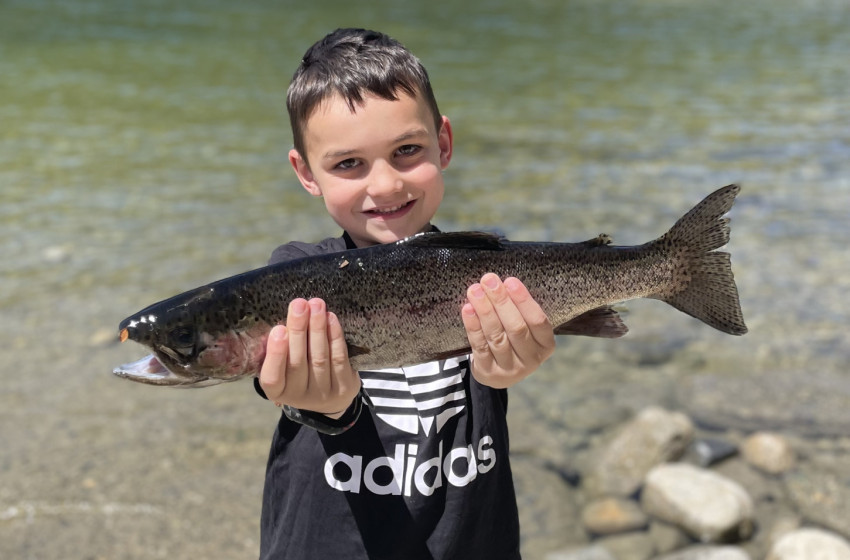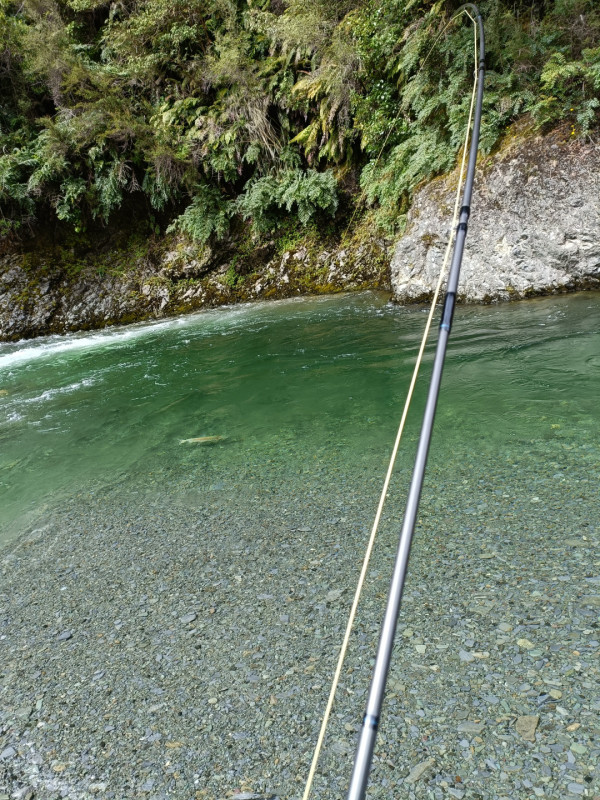Reel Life February 2024 - Southland
- Southland
- 27/02/2024

First Fish!
Congratulations to Rhys Bennett (7) on the first DIY fish - cast, hooked, played & landed all by himself.
A proud moment for him and his father, Richard, who have been fishing Southlands waterways together for the past few seasons.
Above: Satisfaction comes from both the process and the outcome. Lake Monowai. Photo: R. Bennett
Backcountry exploration
The long days & (somewhat!) settled weather of February & March make it a great time to explore new areas.
This could involve committing more time and effort to access those remote and hard to get to locations, or it could be as straightforward as trying a new access point. If you’re struggling for ideas, simply try the one upstream of your usual spot.
Southland has a vast array of backcountry areas – Fiordland National Park, the Eyre & Takitimu Mountains, the Umbrella & Garvie Ranges, Hokonui Hills, Longwoods and the Catlins. These all have significant waterways and offer vast swathes of water to explore.
Online maps and satellite imagery make planning these trips easier than ever before.
Make use of any public 4WD tracks, bridges, and DOC walking tracks. If you have a boat, then even more water is open to you.
You could camp out to maximise your angling opportunities and make better use of your travel dollars.
This is the time of year to make that trip you’ve been thinking about happen. Do it!

A hidden Fiordland gem that isn’t identified on any fishing access map. This pool held a 5.5lb rainbow that confidently took the first fly presented. Photo B. Febery
Website update
We have been updating the Southland section of the Fish & Game website.
So, take a few minutes to ensure you’re up to date with access and how different fisheries are managed.
Of particular use will be our new online access maps that are linked there.
We highly recommend creating a shortcut to these on your phone – you can plan your next trip from the comfort of home or check for nearby access points while on the go.
https://fishandgame.org.nz/freshwater-fishing-in-new-zealand/where-to-fish/regional-info/southland/
Observations from a summer internship with Fish & Game in Northern Southland: Blake Harper
What has been working on the Waikaia River?
Over the past month I have explored the Waikaia River - undertaking compliance checks and angling surveys, while being curious about anglers’ fishing success.
Anglers have been plentiful & success has been varied. Some anglers have encountered challenges in catching fish, while a small percentage have effortlessly brought trout to the bank.
The question arises: What factors have led to the success of these anglers?
- Willow grub - Anglers have had great success using willow grub imitations. When the air temperature heats up by late morning willow grubs can visually be seen falling into the water. Therefore, targeting rising trout along willow-lined banks can be effective.
- Terrestrials - Abundant terrestrial life has offered success. During windy conditions, terrestrial insects like Blowflies and Cicadas are blown onto the water. Anglers find success by mimicking these insects. Smaller cicada imitations are particularly effective in enticing trout.
- Mayflies - Mayfly hatches provide excellent fishing opportunities, often occurring in summer during warmer temperatures and low light conditions. Anglers note that these hatches, though brief, offer great fishing opportunities. As Autumn arrives and water temperatures cool, mayfly hatches become more prolific.
- Nymphs - Trout become less active on some days, prompting anglers to use small nymphs like size 16 Pheasant Tail or Hare and Copper to entice a take. Dry fly purists may find less success during these periods.
Elevated water levels, why not head out for a spin fish?
This summer has seen periodic increases in the river levels, and it has been very noticeable how few anglers fish in the wake of these events when that is often the best time to be out.
Why is this the case?
- Aggression - Trout are known to become more aggressive in dirty water. The decreased visibility affords them less time to make decisions on passing prey causing them to snap more readily.
- Visibility - Murky water can heighten a trout’s feeling of safety and lead them to spend more time in open water. Doubly, the discoloured water also adds cover to an angler’s approach.
- Disruption of feeding & prey - During a flood, trout are sheltering and off the feed. When it subsides, the trout feed voraciously to make up for lost condition. Capitalising on the stirred-up water providing an influx of insects and worms.
What lures/baits to use?
- Bright-coloured soft baits and lures - Bright-coloured soft baits and lures in murky water increase your chances of a trout spotting your lure.
- Natural-coloured soft baits - However, natural-coloured soft baits can be effective when discoloured water is starting to clear. By drifting your soft bait along the bottom of the water column and allowing the current to do the work.
- Bait fishing - Increased water levels provide the perfect opportunity to bait your hook with a worm, either drifting it through the current or casting it into slack water and allowing it to sit.
If the water levels are high and dirty do not be put off. Adjust. Grab your spin rod and make the most of the opportunities heavy rainfall and discoloured waters can offer.

A 3.5lb brown caught on a natural-coloured soft bait in the Hamilton Burn after a flood. Photo: B. Harper
All the best for the next month of fishing and ‘tight lines.’
From the team at Southland Fish & Game.